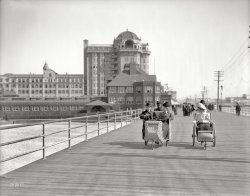
MAY CONTAIN NUTS

Search Shorpy
SHORPY ART

Framed or unframed, desk size to sofa size, printed by us in Arizona and Alabama since 2007. Explore now.
Join and Share
Ad-Free Shorpy
Shorpy is funded by you. Patreon contributors get an ad-free experience.
Learn more.

Recent comments
- Robie House Roof(s)
- There is an interesting novel set here.
- I Was In Berlin
- Pronunciation
- Shell of a Shell
- Never been there but
- BUR-lin
- Hand-made smokes
- Birthplace of Tupperware, or at least its inventor
- Pulp
- Remarkably unchanged in 84 years
- The church is still there ...
- Talk about a smoke show
- Electric Hansom Cab
- I wondered the same thing.
- The location in 2009
- Pill Pusher
- Roll your own
- Rugged and real!
- Civil War history
- Early EV?
- A Charles Purcell - Mama Cass Connection
- Uncle SAAM
- Obfuscation
- One Chocolate Soldier rode away
- Victor Marquis de la Roche
- The Little House Across Way ...
- Vanderbilt Gates
- Vanderbilt Mansion
- You can still see that gate
Member Photos
The Shorpy
Printporium
Printporium
Search Shorpy
Search results -- 30 results per page
- The Dental District: 1905
- ... 1905. "Madison Avenue from Summit Street." Featuring the Hotel Boody and a number of Painless Dentists, as well as a nice display of ... Posted by Dave - 07/30/2014 - 9:50am -
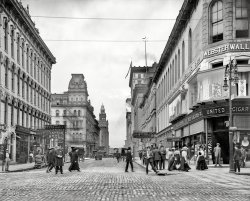
- Sterling Sliver: 1939
- ... just two residents, or maybe the one is waiting for the hotel to open.
Nowadays, they are mining tourist pockets!
+73 Below ... Posted by Dave - 08/14/2020 - 7:18pm -
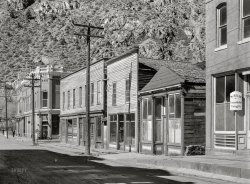
- Powerhouse: 1906
- ... Mississippi, circa 1906. "Powerhouse of the Great Southern Hotel." 8x10 inch dry plate glass negative, Detroit Publishing Company. View ...
Later a Car Dealership Although the Great Southern Hotel was torn down around 1950, the Power Plant building - or atleast portions ... Posted by Dave - 08/14/2014 - 10:58am -
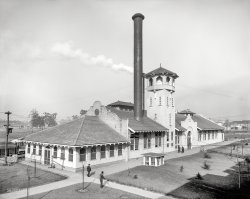
- Special Services: 1944
- ... The synagogue is immediately to the west of the Chelsea Hotel.
How do you have a sign ready for that? I don't understand how you ... Posted by Dave - 06/06/2014 - 10:38am -
![Special Services: 1944 A D-Day triptych. "New York, New York. June 6, 1944. Congregation Emunath Israel. D-Day services in a synagogue on West 23rd Street." Photo by Howard Hollem et al. for the Office of War Information. View full size.
Oh, noThis picture is going to drive me nuts. Emunath Israel (today usually called the "Chelsea Shul") has been at 236 West 23rd Street since the 1920's. Problem is, it occupies a structure originally built as a Methodist church that looks absolutely nothing like what we can see in this picture. It has much plainer stonework, and that's not the sort of thing that would be changed in even a massive renovation.
[It is the same building - formerly a Presbyterian, not Methodist church, - massively renovated. -tterrace]
Emunath IsraelSure looks different nowadays. The photo below is from Thanksgiving 2010. The Hebrew over the door in the recent picture says Emunath Israel: faith of Israel. The two tablets are the ten commandments. The Hebrew in the old picture is Talmud Torah: learning of Torah. The synagogue is immediately to the west of the Chelsea Hotel.
How do you have a sign ready for that?I don't understand how you already have a sign like that painted and ready for the event? Was it common knowledge that there was going to be "a" D-Day and people just didn't know when it was going to happen? Or did they commission this sign and get it painted within a few hours for use that day?
(Panoramas, Howard Hollem, NYC, WW2)](https://www.shorpy.com/files/images/8d36262a-triptych.thumbnail.jpg)
- Wayne Water: 1910
- The Detroit River circa 1910. "Wayne Hotel and pavilion from the river." 8x10 inch dry plate glass negative, Detroit ... Wow.
https://historicdetroit.org/buildings/wayne-hotel
Detroit Hockey's Epicenter Joe Louis arena stood there. ... Posted by Dave - 10/10/2021 - 3:49pm -
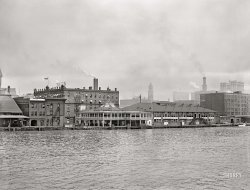
- Sea Water Baths: 1904
- The Jersey Shore in 1904. "Boardwalk at Green's Hotel, Atlantic City." 8x10 inch dry plate glass negative, Detroit Photographic ... Posted by Dave - 07/24/2018 - 11:40am -
![Sea Water Baths: 1904 The Jersey Shore in 1904. "Boardwalk at Green's Hotel, Atlantic City." 8x10 inch dry plate glass negative, Detroit Photographic Company. View full size.
Such Civility!My mom, born in 1920, instructed me at a very early age to always walk to the right-hand side be it a staircase, a sidewalk or a hallway. Everyone stays out of each other’s way and can enjoy the view without worry. No Mexican standoffs! Nowadays you’d think most young people were British the way they hog the left side -- very stressful.
"Do you know what fish do in that stuff?"Despite W.C. Fields' ostensible dislike of good old H2O, very early in his career he had a summer job as a "drowner" for various Jersey Shore hotels. He'd swim out beyond the surf line when there was a decent crowd on the boardwalk and very histrionically thrash about like a drowning man. With commensurate drama, a lifeguard or two would perform an exciting rescue, to the "ooohs" and applause of the tourists.
[Another version of that story can be found here. And yet another here. Both involving concession sales. - Dave]
Someone who claimed to have known Fields once told me that after one such performance, as the future comedian was being borne on a stretcher off the beach, he heard a woman remark, "My God, Mabel! That man must be a hopeless drunkard. It's the third time they've had to rescue him today."
Reflecting on W.C.'s distinctive features, it's clear that he was a poor choice to play a succession of non-descript victims. But he survived to conquer vaudeville, then talking pictures, and leave a legacy that persists until this day, so in a small way we have publicity-hungry Jersey hoteliers to thank for that.
Six years laterFrom a slightly different perspective, here's a view of the beach and the "Richard's Baths" in 1910, from a postcard in the New Jersey Almanac records.
Sun Baths at The PierAtlantic City "Sun Baths" Look closely for the sign.
(The Gallery, Atlantic City, DPC, Swimming)](https://www.shorpy.com/files/images/SHORPY-4a11551a.thumbnail.jpg)
- Piles to New Castle: 1906
- ... wood frame house seen through the trees was really a small hotel which burned to the ground a few years after this photo was taken. But I ... Posted by Dave - 01/12/2021 - 1:11pm -
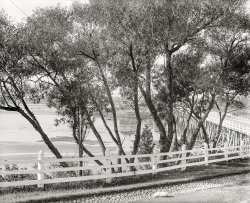
- Arcade Pants Parlors: 1900
- ... today The Arcade Building is now a Hyatt Regency hotel. Here is a modern glamour photo from Hyatt.
(The Gallery, Cleveland, ... Posted by Dave - 02/03/2017 - 9:28am -
![Arcade Pants Parlors: 1900 Cleveland, Ohio, circa 1900. "The Arcade Building, Superior Avenue." (Interior view here.) Ground-floor tenants include the Hat Box, Arcade Pants Parlors and, next door, a Misfit Clothing Parlor (a.k.a. Fitwell Clothing) and Chisholm's Boot Shop. 8x10 inch glass negative, Detroit Publishing Co. View full size.
Cleveland's Cable CarsIf you look closely you can see there are streetcar trolley wires erected over cable car tracks. By 1890 electric streetcars were becoming the standard for urban transit, but in Cleveland in that year cable car service started on two streets: Superior and Payne. The cable service lasted only ten years, and electric streetcars started running on Superior at the time of this photograph. There is more information about Cleveland's cable cars and transit history here.
Wut?"Fitwell Clothing" on the sign and "Misfit Clothing" on the awning; any idea what that's about?
[In the clothing trade of the time, "misfit clothing parlor" was a common appellation for a store or portion of a store that sold what we would today call "irregulars." -tterrace]
Thank'ee kindly!
The Arcade Building todayThe Arcade Building is now a Hyatt Regency hotel. Here is a modern glamour photo from Hyatt.
(The Gallery, Cleveland, Stores & Markets)](https://www.shorpy.com/files/images/SHORPY-4a08341a.thumbnail.jpg)
- Riverbank Court: 1913
- ... stated he was the architect of a $130,000 brick apartment hotel to be constructed in Back Bay. I'm guessing this Cambridge apartment ... Posted by Dave - 08/27/2021 - 2:03pm -
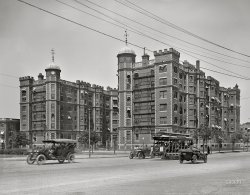
- Carnival of Fire: 1905
- Atlantic City circa 1905. "Hotel Chalfonte and Boardwalk." Where the diversions include shooting flames, ... Posted by Dave - 03/06/2014 - 10:27am -
![Carnival of Fire: 1905 Atlantic City circa 1905. "Hotel Chalfonte and Boardwalk." Where the diversions include shooting flames, rolling chairs and "social drama." 8x10 inch dry plate glass negative, Detroit Publishing Company. View full size.
What could possibly be the job description of the operator of those vehicles?
[Chairman of the Boardwalk. - Dave]
All the newsI swear that the wind blew a newspaper onto the face of the women in the first sedan chair the INSTANT the photo was taken - Hilarious!
[That's the veil of her hat. -tterrace]
The Strenuous LifeNice to see Colonel Roosevelt (right there behind the girl in white) out for a strenuous stroll on the boardwalk!
(The Gallery, Atlantic City, DPC)](https://www.shorpy.com/files/images/SHORPY_4a17669a.thumbnail.jpg)
- 3 Long: 1904
- Circa 1904. "Long Beach Hotel, Long Beach, Long Island, N.Y." On July 29, 1907, this "Riviera of the ... chimney, of course.
Interesting read on The Long Beach Hotel found here .
(The Gallery, DPC) ... Posted by Dave - 05/12/2018 - 12:11pm -
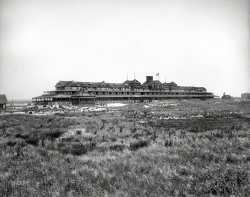
- The Thorndike: 1904
- Boston circa 1904. "Hotel Thorndike, Boylston and Church Sts." Next door to the intriguingly named ... Posted by Dave - 11/29/2012 - 10:04am -
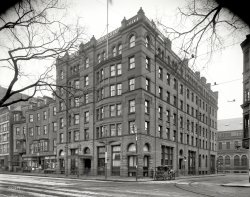
- Washington, D.C.: 1904
- ... Smithsonian Institution." Landmarks include the Willard Hotel at left and Old Post Office tower. 8x10 inch dry plate glass negative, ... Posted by Dave - 08/30/2012 - 10:46am -
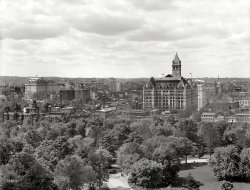
- Miami River: 1904
- ... right of the photo would have been the immense Royal Palm Hotel built by the "Father of Miami", Henry Flagler. I can assure you that, ... Posted by Dave - 01/21/2013 - 1:59pm -
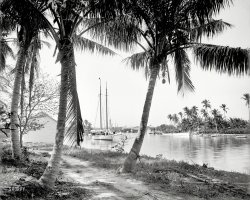
- Ghost Leg Crossing: 1905
- ... on the perimeter of mezzanines upstairs, akin to the hotel rooms in an eighties-style Embassy Suites. The post office's backoffice ... Posted by Dave - 08/02/2020 - 2:55pm -
![Ghost Leg Crossing: 1905 St. Paul, Minnesota, 1905. "Post Office, Fifth and Market Streets." The postal palace last glimpsed here. 8x10 inch glass negative, Detroit Publishing Company. View full size.
Form over functionThis building is much greater as an events center than it was as a federal courthouse. American courthouse designs vary between those that are ugly on the outside but highly functional on the inside, and those (like this one) that look great but don't work well on the inside. There is a massive skylight and atrium inside this one, which consumes most of the space useful for courtrooms. The actual courtrooms were small, narrow, and unremarkable, on the perimeter of mezzanines upstairs, akin to the hotel rooms in an eighties-style Embassy Suites. The post office's backoffice operations occupied much of the atrium floor, making the views down from the mezzanines depressing.
The Beautiful and (nearly) DamnedTo think, this building was nearly razed, before being saved by more conscientious citizens back in the '70s.
I recall paying a visit to F. Scott Fitzgerald (in statue form) just across West Fifth Street, and being struck by this magnificent building as a backdrop: This Side of Fifth.
One leg only --Perhaps, Holmes, it was a man with a limp?
[Actually we see both legs here, alternating L and R. - Dave]
No HandsSomewhere along the line they put a clock up in the clockless clock tower.
(The Gallery, DPC, Minneapolis-St. Paul)](https://www.shorpy.com/files/images/SHORPY-4a12316a.thumbnail.jpg)
- Spanish-American War Veteran
- ... Rider Reunion of June 24-26, 1899 was held at the Plaza Hotel in Las Vegas, New Mexico. The hotel is still there, although the modern bar doesn't seem to fit the picture ... Posted by carolelinda - 05/23/2014 - 7:03pm -
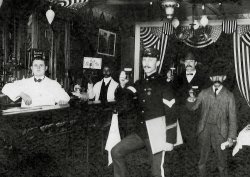
- Lafayette Square: 1911
- ... the large brick building in the center. But the Lafayette Hotel is still there, as is the Kleinhans building. Both are largely unchanged, ... Posted by Dave - 05/22/2014 - 6:47am -
![Lafayette Square: 1911 Buffalo, New York, circa 1911. "Lafayette Square." Where amusements include Motion Pictures, Vaudeville, a Pony Circus and, for the more practical-minded, Gas & Electric Fixtures. 8x10 inch glass negative. View full size.
The fun is goneAll of the buildings on the left are gone, as is the large brick building in the center. But the Lafayette Hotel is still there, as is the Kleinhans building. Both are largely unchanged, externally.
Pointed QuestionDoes anyone know what the center building was called and used for? I'm fascinated by it. I'm so glad the others are still standing. Thanks.
[Buffalo Public Library. Demolished c.1960 and replaced by the current library building. -tterrace]
(The Gallery, Buffalo NY, Cars, Trucks, Buses, DPC)](https://www.shorpy.com/files/images/SHORPY-4a25249a.thumbnail.jpg)
- Carnivale: 1941
- ... to the north (east/west where the corner for the Vale Hotel is in the background). Maybe hurrying towards the fair?
[The fair ... Posted by Dave - 02/22/2019 - 4:14pm -
![Carnivale: 1941 July 1941. "People in Vale, Oregon, for the Fourth of July celebration." Acetate negative by Russell Lee for the Farm Security Administration. View full size.
High fashionThe clothing here is outstanding. I sometimes force myself to look at slideshows of couture extravaganzas, with all the runway nonsense, and this stuff here, in Oregon in 1941, is downright beautiful. All the clothing looks skillfully homemade or easily purchased. That woman with glasses in front, holding the little boy’s hand, is just plain gorgeous. That blouse, the buttons, that waistband, the pants, even the saddle shoes – she’s a knockout.
[Her blouse looks like rayon. - Dave]
SimplicitySometimes I forget there was a time when everyone's clothing didn't bombard us with brand names and logos.
Main street U.S.A. Much of it survives.
Vale, Oregon scenes - July 4, 1941There's video below for anyone interested in seeing a wonderful slideshow of pictures from that day in Vale.
Seems most of the folks shown in the photo above are walking away (south) from a then-finished parade, as it was held on "A Street" to the north (east/west where the corner for the Vale Hotel is in the background). Maybe hurrying towards the fair?
[The fair is in the photo. See the Ferris wheel on the right? - Dave]
(The Gallery, July 4, Kids, Russell Lee, Small Towns)](https://www.shorpy.com/files/images/SHORPY-8c01704a.thumbnail.jpg)
- Our Lady of the Ascension: 1941
- ...
Formerly St. Mary's Church and Parish. Now a hotel, saved from what seemed to be certain destruction:
... Posted by Dave - 07/08/2020 - 10:47am -
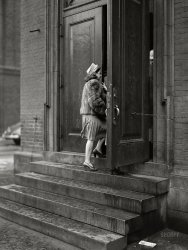
- The Richmond: 1908
- North Adams, Massachusetts, circa 1908. "Richmond Hotel, Main Street." 8x10 inch dry plate glass negative, Detroit Publishing ... Posted by Dave - 10/26/2020 - 2:19pm -
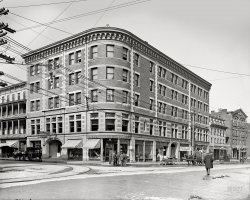
- High Rock: 1903
- ... dancing at this lookout. My grandfather's family had a hotel in Pen-Mar and in summers from about 1905-1915, as a boy, he used to ... Posted by Dave - 07/29/2012 - 6:17pm -
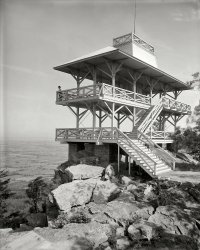
- Windsor Castle: 1906
- Atlantic City, New Jersey, circa 1906. "Hotel Windsor and Boardwalk." 8x10 inch dry plate glass negative, Detroit ... Posted by Dave - 07/30/2012 - 4:34pm -
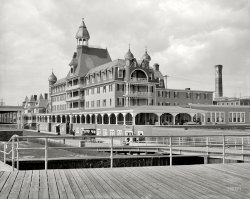
- Crossing Canal: 1890
- New Orleans circa 1890. "St. Charles Hotel from Canal Street." 5x7 inch glass negative by William Henry Jackson. ... Posted by Dave - 03/17/2019 - 9:47am -
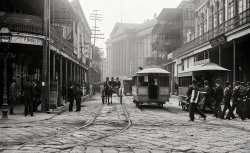
- Avenue B: 1910
- Circa 1910. "Hotel Halcyon and Avenue B looking north -- Miami, Fla." 8x10 inch dry plate ... Posted by Dave - 08/21/2014 - 10:59am -
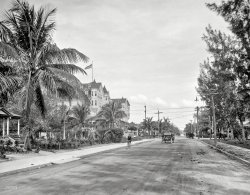
- Sweet Street: 1907
- ... was recently renovated and turned into a rather nice hotel.
(The Gallery, Cincinnati Photos, DPC, Stores & Markets, Streetcars) ... Posted by Dave - 09/23/2016 - 12:03am -
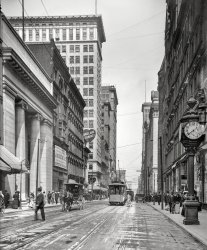
- Work Zone: 1920
- ... versions of this image are at the LOC ). The Willard Hotel is visible at left.
(The Gallery, D.C., Natl Photo) ... Posted by Dave - 05/17/2014 - 11:50pm -
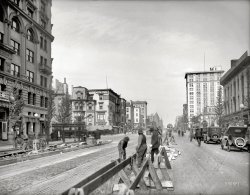
- Mime Goes Motoring: 1910
- ... report that "Mime" is the dog, a Papillon who lived at the Hotel Walton in New York City and was by all accounts a fan of fast cars ... Posted by Dave - 09/08/2011 - 12:58pm -
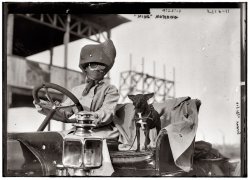
- The Shelburne: 1910
- Atlantic City circa 1910. "The Boardwalk and Hotel Shelburne." 8x10 inch dry plate glass negative, Detroit Publishing ... Posted by Dave - 01/30/2020 - 12:25pm -
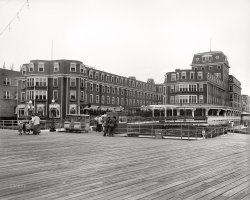
- The Pavilion: 1910
- Detroit circa 1910. "Wayne Hotel pavilion, Third Street, Detroit River." Belle Isle Park steamers dock ... combination of bike, rack, concrete, cast, curb, Wayne Hotel, Detroit, etc, that I can think of. I give up.
[Seems obvious to ... Posted by Dave - 10/26/2018 - 11:32am -
![The Pavilion: 1910 Detroit circa 1910. "Wayne Hotel pavilion, Third Street, Detroit River." Belle Isle Park steamers dock every 20 minutes! 8x10 glass negative. View full size.
Dave, if you knowwhat the jagged blocks at the curb are, please enlighten me. I think they are bicycle racks.
I have spent about 3 hours googling every combination of bike, rack, concrete, cast, curb, Wayne Hotel, Detroit, etc, that I can think of. I give up.
[Seems obvious to me! - Dave]
(The Gallery, Detroit Photos, DPC)](https://www.shorpy.com/files/images/SHORPY-4a20073a.thumbnail.jpg)
- Passing Lane: 1906
- ... 1906. "Rolling chairs on the Boardwalk, Atlantic City." Hotel Traymore in the background. 8x10 inch glass negative. View full size. ... Posted by Dave - 07/19/2012 - 12:56pm -
